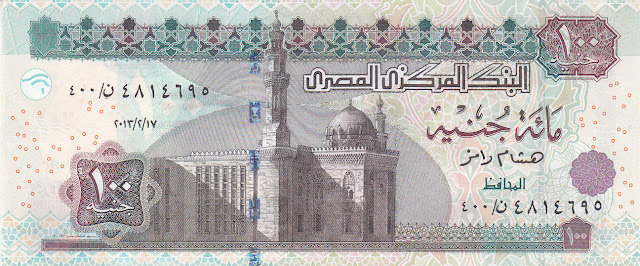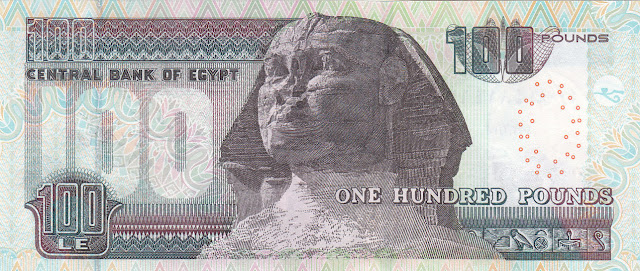Egypt banknotes 100 Pounds banknote 2013 Sphinx
Central Bank of Egypt
Obverse: Sultan Hassan Mosque in Cairo; Islamic ornamental patterns. Eye of Horus See- through registration.
Reverse: The Head of the Great Sphinx of Giza.
Watermark: Sphinx and the value of the note in Electrotype.
Original Size: 166 x 70 mm
Texts: Central Bank of Egypt; One Hundred Pounds.
Egypt Banknotes - Egyptian Paper Money
1978-2008 Issue
25 Piastres 50 Piastres 1 Pound 5 Pounds 10 Pounds
20 Pounds 100 Pounds
1994-2014 Issue
50 Piastres 5 Pounds 10 Pounds 20 Pounds 50 Pounds
100 Pounds 200 Pounds
25 Piastres 50 Piastres 1 Pound 5 Pounds 10 Pounds
20 Pounds 100 Pounds
1994-2014 Issue
50 Piastres 5 Pounds 10 Pounds 20 Pounds 50 Pounds
100 Pounds 200 Pounds
Great Sphinx of Giza
The Great Sphinx of Giza (English: The Terrifying One; literally: Father of Dread), commonly referred to as the Sphinx, is a limestone statue of a reclining or couchant sphinx (a mythical creature with a lion's body and a human head) that stands on the Giza Plateau on the west bank of the Nile in Giza, Egypt. The face of the Sphinx is generally believed to represent the face of the Pharaoh Khafra.
It is the largest monolith statue in the world, standing 73.5 metres (241 ft) long, 19.3 metres (63 ft) wide, and 20.22 m (66.34 ft) high. It is the oldest known monumental sculpture, and is commonly believed to have been built by ancient Egyptians of the Old Kingdom during the reign of the Pharaoh Khafra (c. 2558–2532 BC).
The Great Sphinx is one of the world's largest and oldest statues but basic facts about it are still subject to debate, such as when it was built, by whom, and for what purpose. These questions have resulted in the popular idea of the "Riddle of the Sphinx", alluding to the original Greek legend of the Riddle of the Sphinx.
Pliny the Elder mentioned the Great Sphinx in his book, Natural History, commenting that the Egyptians looked upon the statue as a "divinity" that has been passed over in silence and "that King Harmais was buried in it".
Names of the Sphinx
It is not known by what name the creators called their statue, as the Great Sphinx does not appear in any known inscription of the Old Kingdom, and there are no inscriptions anywhere describing its construction or its original purpose. In the New Kingdom, the Sphinx was called Hor-em-akhet (English: Horus of the Horizon; Hellenized: Harmachis), and the pharaoh Thutmose IV (1401–1391 or 1397–1388 BC) specifically referred to it as such in his Dream Stele.
The commonly used name Sphinx was given to it in classical antiquity, about 2000 years after the commonly accepted date of its construction, by reference to a Greek mythological beast with a lion's body, a woman's head and the wings of an eagle (although, like most Egyptian sphinxes, the Great Sphinx has a man's head and no wings). The English word sphinx comes from the ancient Greek Σφίγξ (transliterated: sphinx), apparently from the verb σφίγγω (transliterated: sphingo / English: to squeeze), after the Greek sphinx who strangled anyone who failed to answer her riddle.
The name may alternatively be a linguistic corruption of the phonetically different ancient Egyptian word Ssp-anx (in Manuel de Codage). This name is given to royal statues of the Fourth dynasty of ancient Egypt (2575–2467 BC), and later in the New Kingdom (c. 1570–1070 BC) to the Great Sphinx more specifically.
Missing nose and beard
The one-metre-wide nose on the face is missing. Examination of the Sphinx's face shows that long rods or chisels were hammered into the nose, one down from the bridge and one beneath the nostril, then used to pry the nose off towards the south.
The Arab historian al-Maqrīzī, writing in the 15th century, attributes the loss of the nose to iconoclasm by Muhammad Sa'im al-Dahr, a Sufi Muslim from the khanqah of Sa'id al-Su'ada. In AD 1378, upon finding the local peasants making offerings to the Sphinx in the hope of increasing their harvest, Sa'im al-Dahr was so outraged that he destroyed the nose, and was hanged for vandalism. Al-Maqrīzī describes the Sphinx as the "talisman of the Nile" on which the locals believed the flood cycle depended.
There is also a story that the nose was broken off by a cannonball fired by Napoleon's soldiers, that still lives on today. Other variants indict British troops, the Mamluks, and others. Sketches of the Sphinx by the Dane Frederic Louis Norden, made in 1738 and published in 1757, show the Sphinx missing its nose. This predates Napoleon's birth in 1769.
In addition to the lost nose, a ceremonial pharaonic beard is thought to have been attached, although this may have been added in later periods after the original construction. Egyptologist Vassil Dobrev has suggested that had the beard been an original part of the Sphinx, it would have damaged the chin of the statue upon falling. The lack of visible damage supports his theory that the beard was a later addition.
Mythology
Colin Reader has proposed that the Sphinx was probably the focus of solar worship in the Early Dynastic Period, before the Giza Plateau became a necropolis in the Old Kingdom (c. 2686–2134 BC). He ties this in with his conclusions that the Sphinx, the Sphinx temple, the Causeway and the Khafra mortuary temple are all part of a complex which predates Dynasty IV (c. 2613–2494 BC). The lion has long been a symbol associated with the sun in ancient Near Eastern civilizations. Images depicting the Egyptian king in the form of a lion smiting his enemies date as far back as the Early Dynastic Period.
In the New Kingdom, the Sphinx became more specifically associated with the god Hor-em-akhet (Hellenized: Harmachis) or "Horus-at-the-Horizon", which represented the pharaoh in his role as the Shesep-ankh (English: Living Image) of the god Atum. Pharaoh Amenhotep II (1427–1401 or 1397 BC) built a temple to the north east of the Sphinx nearly 1000 years after its construction, and dedicated it to the cult of Hor-em-akhet.
Eye of Horus
The Eye of Horus is an ancient Egyptian symbol of protection, royal power and good health. The eye is personified in the goddess Wadjet (also written as Wedjat, or "Udjat", Uadjet, Wedjoyet, Edjo or Uto). It is also known as ''The Eye of Ra''.
The name Wadjet is derived from "wadj" meaning "green", hence "the green one", and was known to the Greeks and Romans as "uraeus" from the Egyptian "iaret" meaning "risen one" from the image of a cobra rising up in protection. Wadjet was one of the earliest of Egyptian deities who later became associated with other goddesses such as Bast, Sekhmet, Mut, and Hathor. She was the tutelary deity of Lower Egypt and the major Delta shrine the "per-nu" was under her protection. Hathor is also depicted with this eye.
Funerary amulets were often made in the shape of the Eye of Horus. The Wadjet or Eye of Horus is "the central element" of seven "gold, faience, carnelian and lapis lazuli" bracelets found on the mummy of Shoshenq II. The Wedjat "was intended to protect the pharaoh in the afterlife" and to ward off evil. Ancient Egyptian and Near Eastern sailors would frequently paint the symbol on the bow of their vessel to ensure safe sea travel.

